
Cortinarius rubellus, commonly known as the deadly webcap, is a species of fungus in the family Cortinariaceae, native to high-latitude temperate to subalpine forests of Eurasia and North America. Within the genus it belongs to a group known as the Orellani, all of which are highly toxic. Eating them results in kidney failure, which is often irreversible. The mushroom is generally tan to brown all over, with a conical to convex cap 2.5 to 8 centimetres in diameter, adnate gills and a 5.5 to 11 cm tall stipe.

Cortinarius is a globally distributed genus of mushrooms in the family Cortinariaceae. It is suspected to be the largest genus of agarics, containing over 2,000 widespread species. A common feature among all species in the genus Cortinarius is that young specimens have a cortina (veil) between the cap and the stem, hence the name, meaning curtained. Most of the fibres of the cortina are ephemeral and will leave no trace once gone, except for limited remnants on the stem or cap edge in some species. All have a rusty brown spore print. The common names cortinar and webcap refer to members of the genus. Due to dangerous toxicity of several species and the fact that it is difficult to distinguish between various species of the genus, non-expert consumption of mushrooms from the genus is discouraged.

Clitocybe nuda, commonly known as the blewitwood blewit and alternately described as Lepista nuda, is an edible mushroom native to Europe and North America. Described by Pierre Bulliard in 1790, it was also known as Tricholoma nudum for many years. It is found in both coniferous and deciduous woodlands. It is a fairly distinctive mushroom that is widely eaten, though there is some caution about edibility. Nevertheless, it has been cultivated in Britain, the Netherlands and France.
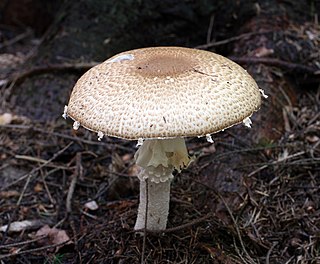
Agaricus augustus, known commonly as the prince, is a basidiomycete fungus of the genus Agaricus.

Cortinarius caperatus is an edible mushroom of the genus Cortinarius found in northern regions of Europe and North America. It was known as Rozites caperata for many years before genetic studies revealed that it belonged to the genus Cortinarius. The fruit bodies appear in autumn in coniferous and beech woods as well as heathlands in late summer and autumn. The ochre-coloured cap is up to 10 cm (4 in) across and has a fibrous surface. The clay-colored gills are attached to the stipe under the cap, and the stipe is whitish with a whitish ring. The Latin specific name, caperatus, means wrinkled, and refers to the distinctive texture of the cap. The flesh has a mild smell and flavor.
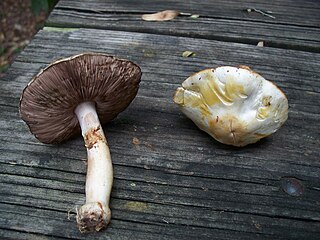
Agaricus abruptibulbus is a species of mushroom in the genus Agaricus. It is commonly known as the abruptly-bulbous agaricus or the flat-bulb mushroom. First described by the mycologist Charles Horton Peck, this bulbous-stemmed edible species smells slightly of anise or bitter almond, and turns yellow when bruised or cut. The mushroom is medium-sized, with a white, yellow-staining cap on a slender stipe that has a wide, flat bulb on the base.

Cortinarius mucosus, commonly known as the orange webcap or the slimy cortinarius, is a species of mushroom in the family Cortinariaceae. In North America, the species is more commonly associated with northern coniferous forests. The specific epithet is derived from the Latin word mucosus, meaning mucus.

Cortinarius violaceus, commonly known as the violet webcap or violet cort, is a fungus in the webcap genus Cortinarius native across the Northern Hemisphere. The fruit bodies are dark purple mushrooms with caps up to 15 cm (6 in) across, sporting gills underneath. The stalk measures 6 to 12 centimetres by 1 to 2 cm, sometimes with a thicker base. The dark flesh has a smell reminiscent of cedar wood. Forming symbiotic (ectomycorrhizal) relationships with the roots of various plant species, C. violaceus is found predominantly in conifer forests in North America and deciduous forests in Europe.

Cortinarius archeri is a species of mushroom in the genus Cortinarius native to Australia. The distinctive mushrooms have bright purple caps that glisten with slime, and appear in autumn in eucalypt forests.

Cortinarius traganus, also known as the gassy webcap, is a basidiomycete mushroom of the genus Cortinarius. The mushrooms are characterized by their lilac color, the rusty-brown gills and spores, and rusty-brown flesh in the stem.
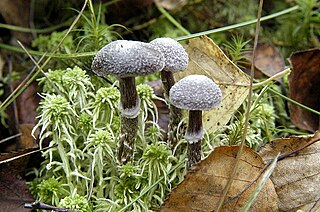
Cortinarius hemitrichus, also known as the frosty webcap, is a basidiomycete mushroom of the genus Cortinarius. Young mushrooms are characterized by their brown cone-shaped caps covered with dense white fibrils.

Cortinarius anomalus, also known as the variable webcap, is a basidiomycete fungus of the genus Cortinarius. It produces a medium-sized mushroom with a grayish-brown cap up to 5 cm (2 in) wide, gray-violet gills and a whitish stem with pale yellow belts below. The mushroom grows solitarily or in scattered groups on the ground in deciduous and coniferous forests. It is found throughout the temperate zone of the northern hemisphere.

The Orellani are a group of seven related species in the genus Cortinarius that have been classified as a section of the subgenus Leprocybe or a subgenus in their own right. They are among world's most poisonous mushrooms as they contain the highly toxic compound orellanine. The best-known species are the deadly webcap and the fool's webcap, C. orellanus.
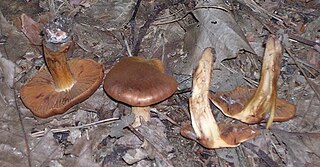
Cortinarius orellanus, commonly known as the fool's webcap or fools webcap, is a species of deadly fungus in the family Cortinariaceae native to Europe. Within the genus it belongs to a group known as the Orellani, all of which are highly toxic—eating them results in kidney failure, which is often irreversible. The mushroom is generally tan to brown all over.

Cortinarius vanduzerensis is a species of mushroom in the family Cortinariaceae. Described as new to science in 1972, it is known only from the Pacific Northwest region of North America, where it grows under conifers such as spruce, hemlock, and Douglas-fir. The fruit bodies of the fungus, or mushrooms, have a slimy dark chestnut-brown cap that becomes deeply radially grooved or corrugated in maturity, and reaches diameters of up to 8 cm. The gills on the underside of the cap are initially pinkish-buff before becoming pale brown when the spores mature. The stem is lavender, measuring 10–18 cm (4–7 in) long and 1–2 cm thick. The mushroom produces a rusty-brown spore print, with individual spores measuring 12–14 by 7–8 micrometers. The edibility of the mushroom has not been determined, and it has been described as "much too slippery to be of value".

Meinhard Michael Moser was an Austrian mycologist. His work principally concerned the taxonomy, chemistry, and toxicity of the gilled mushrooms (Agaricales), especially those of the genus Cortinarius, and the ecology of ectomycorrhizal relationships. His contributions to the Kleine Kryptogamenflora von Mitteleuropa series of mycological guidebooks were well regarded and widely used. In particular, his 1953 Blätter- und Bauchpilze [The Gilled and Gasteroid Fungi ], which became known as simply "Moser", saw several editions in both the original German and in translation. Other important works included a 1960 monograph on the genus Phlegmacium and a 1975 study of members of Cortinarius, Dermocybe, and Stephanopus in South America, co-authored with the mycologist Egon Horak.
Cortinarius badiolaevis is a fungus in the family Cortinariaceae. The species produces mushrooms with smooth, red-brown caps up to 5 centimetres (2.0 in) in diameter, after which it is named. It has a white stem, and yellow-brown gills. It was first described in 2011, based on specimens collected in the 1990s and 2000s. C. badiolaevis is part of the subgenus Telamonia, but is not part of any known section, and does not have any close relatives within the genus. The rare species is known from Sweden and Spain, where it grows from soil in coniferous woodland.
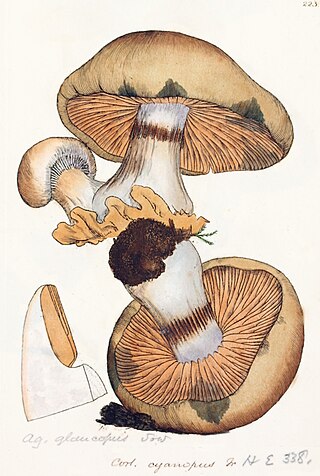
Phlegmacium glaucopus is a species of fungus in the family Cortinariaceae. It is commonly known as the blue-foot webcap.

Cortinarius kioloensis is a fungus native to Australia. It was described in 2009 by Alec Wood, and is related to the Northern Hemisphere species Cortinarius violaceus.
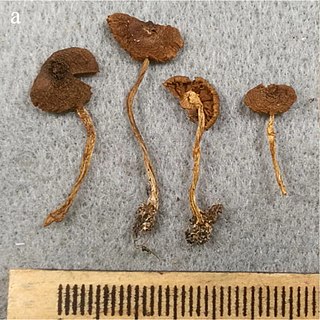
Cortinarius subsaniosus is a species of webcap mushroom known from north and central Europe, where it grows on sandy soil in association with willows. It produces small yellowish brown mushrooms. The species was described in 2020 by Kare Liimatainen and Tuula Niskanen. Its name refers to its affinity to C. saniosus, to which it is closely related. Along with five other British webcaps, C. subsaniosus was selected by Kew Gardens as a highlight of taxa described by the organisation's staff and affiliates in 2020.

















